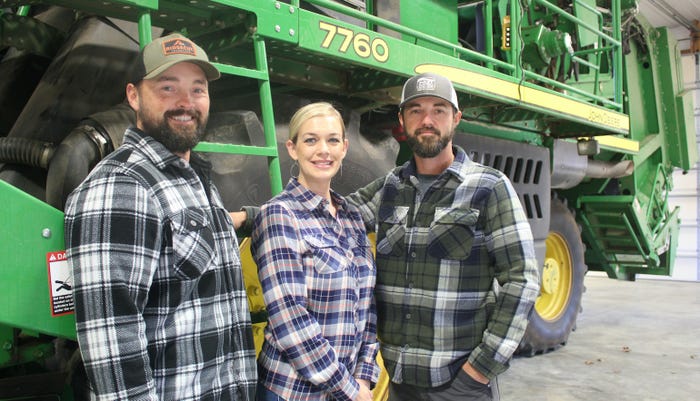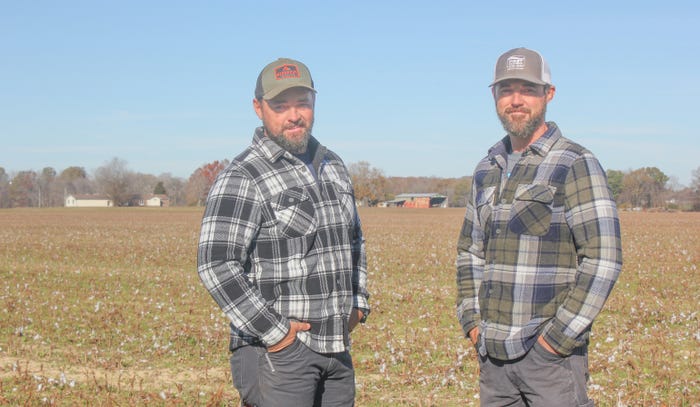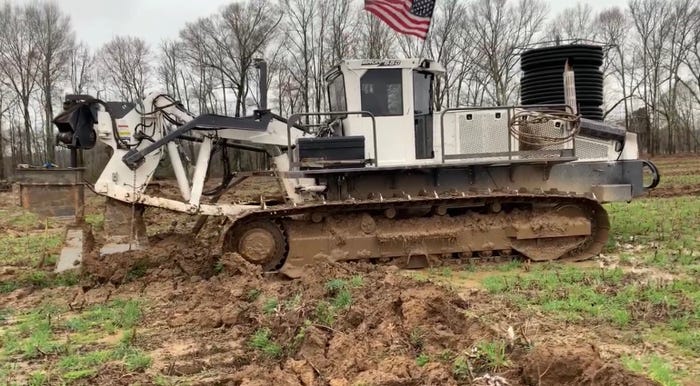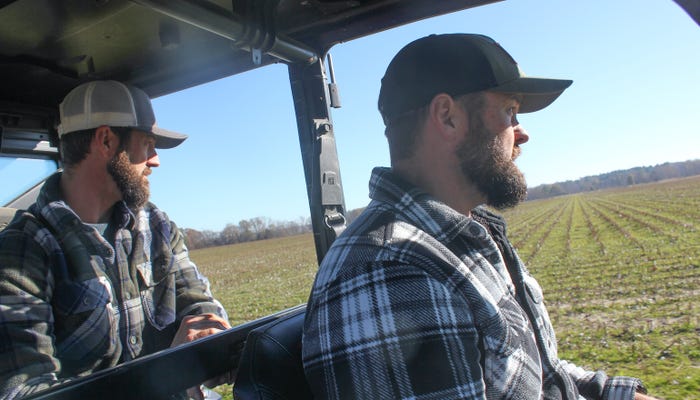
Tennessee cotton growers Jeff, Brandi and Rusty Harris saw promising results after one year with a subsurface drainage system. Ginger Rowsey
Cotton producers and brothers Rusty and Jeff Harris can’t stop gushing about their newly installed tile drainage, and it’s easy to understand why.
In January, they laid subsurface drainage on about 90 acres of their two farms. After one season, the cotton planted on the tiled fields was averaging 150-200 pounds better than the overall average of each farm. In one case, the tiled ground outperformed non-tiled ground, planted to the same cotton variety, by more than 300 pounds in a side-by-side comparison.
A good scientist will tell you a study should always be replicated to increase the validity of the results, but any cotton farmer will say a 300-pound yield increase is hard to ignore.
“I was told it would take three years to be fully effective,” said Rusty, “so, the results of this first year are very encouraging. I’m really excited going forward.”
Jeff described it as a perfect stand.
“Aside from the yield, it means a lot knowing we can get in a field when we want to,” Jeff said. “And we saw a more consistent stand, where before I had one spot that would just stay wet.”

Planting timely
Rusty Harris took over the family farm 15 years ago after the passing of his father. He was only 22. Several years later, twin brother Jeff joined him, eventually picking up some of his own ground. Today, the brothers and Rusty’s wife, Brandi, farm a combined 2,100 acres near Henderson, Tenn.
They’re predominantly cotton growers, although they have corn and soybeans in the rotation, too. With only three employees, there’s a lot of pressure to get across all their acres within a short window. It’s something that influenced their decision to invest in tile.
“This wasn’t the wettest ground I farm,” said Rusty as he walks over one of his tiled fields, “but the last few years I couldn’t plant it timely. That’s the biggest thing. I wanted that peace of mind that I could get it planted on time and then also the benefit of yield on top of it.”
As it turns out, he only planted the tile ground about four days earlier than the non-tiled comparison, but Rusty recalls his tile ground was dry, while four days later the ground beside it was still muddy.
“It was not optimal planting conditions, but sometimes you’ve got to go if you’re going to get it planted.”
University of Tennessee Extension Cotton Specialist Tyson Raper agrees that tile can usually allow a grower to get in the field earlier in wet springs.
“While we typically worry about not having enough rain, having too much rain during April, May and June can create saturated soil conditions,” Raper said. “During several periods over the past few years, I’ve seen saturated soil conditions in field bottoms negatively impact cotton yields. Tile can help reduce the amount of time the soil is saturated and allow the cotton plant to continue to function normally.”

Installing tile drainage
Tile drainage has been around more than 200 years and has even been described as a “way of life” for farmers in northern states. But tile is now having a moment in the Mid-South, as more fields become testimonials to its effect on earlier planting dates and better crop yields.
While it may seem counterintuitive, experts say lowering the water table to a proper level is healthy for plants, as it encourages deeper root growth. In poorly drained soil, root growth is restricted by the high water table early in the season. During summer, when the water table drops quickly, further root and crop growth are impaired. With subsurface drainage, plants develop deeper roots in the spring, and can access deeper water during the dry periods of summer.
“We observed that first-hand this year,” Jeff said. “When it was bone-dry in July, the tiled cotton never looked as stressed as the rest of the ground, and we dropped the water table 30 inches.”
Designing an effective tile drainage system depends on many factors, including the water table level, soil texture and field elevation and slope. On the Harris’ farms, the drainpipes are buried 30 inches deep, with three-inch lateral pipes emptying into an eight-inch main outlet that flows into a pre-existing canal. Jeff recalls that within minute of hooking the laterals to the main outlet, water was running like a firehose.
The Harris’ tile drainage was installed by Phillip Reed of Reed’s Farm Drainage.
“Jeff and Rusty are some of the first guys I’ve tiled for that have planted cotton,” said Reed. “The cotton producer is a little bit of a harder sell because the time of year that they get to plant cotton is typically already dry. But the past several years we’ve seen historical rains in odd parts of the year. It’s my experience a plant can last longer without water than it can with too much.”
Rusty agrees. “Each year we’re struggling to plant timely, and I say, ‘It can’t get much wetter than this.’ And each year it seems a little wetter than the year before. The tile has somewhat eliminated that roadblock.”

Committed to conservation
Stewardship has always been important to the Harris’. They’re a predominantly no-till operation and were early adapters of cover crops in their area. They see tile drainage as another conservation practice.
“We’re creating a healthier root zone for the plant,” Rusty said. “I’m excited for the cover crop now. Get some biomass and roots down there to increase infiltration.”
“People want to say tiling contributes to water quality problems, but the water coming out of that main pipe was crystal clear,” said Jeff. “Hardly any sediment compared to surface runoff.”
Lessons of 2020
The Harris’ were turned on to tile drainage by other farmers in their community who have had great success with subsurface drainage. Although no one they talked with had much experience tiling cotton ground, the Harris’ felt encouraged that they would see a return on the investment. (While drainage system installation costs can vary significantly from farm to farm, the University of Tennessee estimates the costs to be roughly $1,000 to $1,500 per acre.)
“It was a huge investment,” Rusty admitted. “But at today’s prices, and with those yield increases, you could have your investment paid back in six years or less.”
2020 also saw the Harris brothers invest in a PTO Ditcher to remove surface water.
“You learn something every year in farming,” Jeff said, “and 2020’s lesson was the importance of drainage.”
Adds Rusty, “I do now see that drainage is so key to minimizing plant stress, and that equates to yield.”
As they look ahead to 2021, Rusty and Jeff say they are eager to see how their investment continues to payoff.
“I’m excited,” Jeff said. “There’s a confidence in that ground, and we know we can make some things happen there.”
About the Author(s)
You May Also Like






